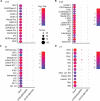Identification and characterization of key long non-coding RNAs in the mouse cochlea
- PMID: 33131415
- PMCID: PMC8244781
- DOI: 10.1080/15476286.2020.1836456
Identification and characterization of key long non-coding RNAs in the mouse cochlea
Abstract
The auditory system is a complex sensory network with an orchestrated multilayer regulatory programme governing its development and maintenance. Accumulating evidence has implicated long non-coding RNAs (lncRNAs) as important regulators in numerous systems, as well as in pathological pathways. However, their function in the auditory system has yet to be explored. Using a set of specific criteria, we selected four lncRNAs expressed in the mouse cochlea, which are conserved in the human transcriptome and are relevant for inner ear function. Bioinformatic characterization demonstrated a lack of coding potential and an absence of evolutionary conservation that represent properties commonly shared by their class members. RNAscope® analysis of the spatial and temporal expression profiles revealed specific localization to inner ear cells. Sub-cellular localization analysis presented a distinct pattern for each lncRNA and mouse tissue expression evaluation displayed a large variability in terms of level and location. Our findings establish the expression of specific lncRNAs in different cell types of the auditory system and present a potential pathway by which the lncRNA Gas5 acts in the inner ear. Studying lncRNAs and deciphering their functions may deepen our knowledge of inner ear physiology and morphology and may reveal the basis of as yet unresolved genetic hearing loss-related pathologies. Moreover, our experimental design may be employed as a reference for studying other inner ear-related lncRNAs, as well as lncRNAs expressed in other sensory systems.
Keywords: Deafness; Hearing; Inner ear; LncRNA; Notch.
Figures
Similar articles
-
The long and short: Non-coding RNAs in the mammalian inner ear.Hear Res. 2023 Feb;428:108666. doi: 10.1016/j.heares.2022.108666. Epub 2022 Dec 16. Hear Res. 2023. PMID: 36566643 Free PMC article. Review.
-
Genome-wide identification and expression profiling of long non-coding RNAs in auditory and vestibular systems.Sci Rep. 2017 Aug 17;7(1):8637. doi: 10.1038/s41598-017-08320-3. Sci Rep. 2017. PMID: 28819115 Free PMC article.
-
A comprehensive catalogue of the coding and non-coding transcripts of the human inner ear.Hear Res. 2016 Mar;333:266-274. doi: 10.1016/j.heares.2015.08.013. Epub 2015 Sep 1. Hear Res. 2016. PMID: 26341477 Free PMC article.
-
Systematic identification and comparison of expressed profiles of lncRNAs and circRNAs with associated co-expression and ceRNA networks in mouse germline stem cells.Oncotarget. 2017 Apr 18;8(16):26573-26590. doi: 10.18632/oncotarget.15719. Oncotarget. 2017. PMID: 28404936 Free PMC article.
-
Recent advancements in understanding the role of epigenetics in the auditory system.Gene. 2020 Nov 30;761:144996. doi: 10.1016/j.gene.2020.144996. Epub 2020 Jul 29. Gene. 2020. PMID: 32738421 Free PMC article. Review.
Cited by
-
The Genomics of Auditory Function and Disease.Annu Rev Genomics Hum Genet. 2022 Aug 31;23:275-299. doi: 10.1146/annurev-genom-121321-094136. Epub 2022 Jun 6. Annu Rev Genomics Hum Genet. 2022. PMID: 35667089 Free PMC article. Review.
-
A cell type-specific approach to elucidate the role of miR-96 in inner ear hair cells.Front Audiol Otol. 2024;2:1400576. doi: 10.3389/fauot.2024.1400576. Epub 2024 May 9. Front Audiol Otol. 2024. PMID: 38826689 Free PMC article.
-
The long and short: Non-coding RNAs in the mammalian inner ear.Hear Res. 2023 Feb;428:108666. doi: 10.1016/j.heares.2022.108666. Epub 2022 Dec 16. Hear Res. 2023. PMID: 36566643 Free PMC article. Review.
-
The noncoding genome and hearing loss.Hum Genet. 2022 Apr;141(3-4):323-333. doi: 10.1007/s00439-021-02359-z. Epub 2021 Sep 7. Hum Genet. 2022. PMID: 34491412 Review.
References
-
- Richardson GP, de Monvel JB, Petit C. How the genetics of deafness illuminates auditory physiology. Annu Rev Physiol. 2011;73:311–334. - PubMed
Publication types
MeSH terms
Substances
Grants and funding
LinkOut - more resources
Full Text Sources
Other Literature Sources





